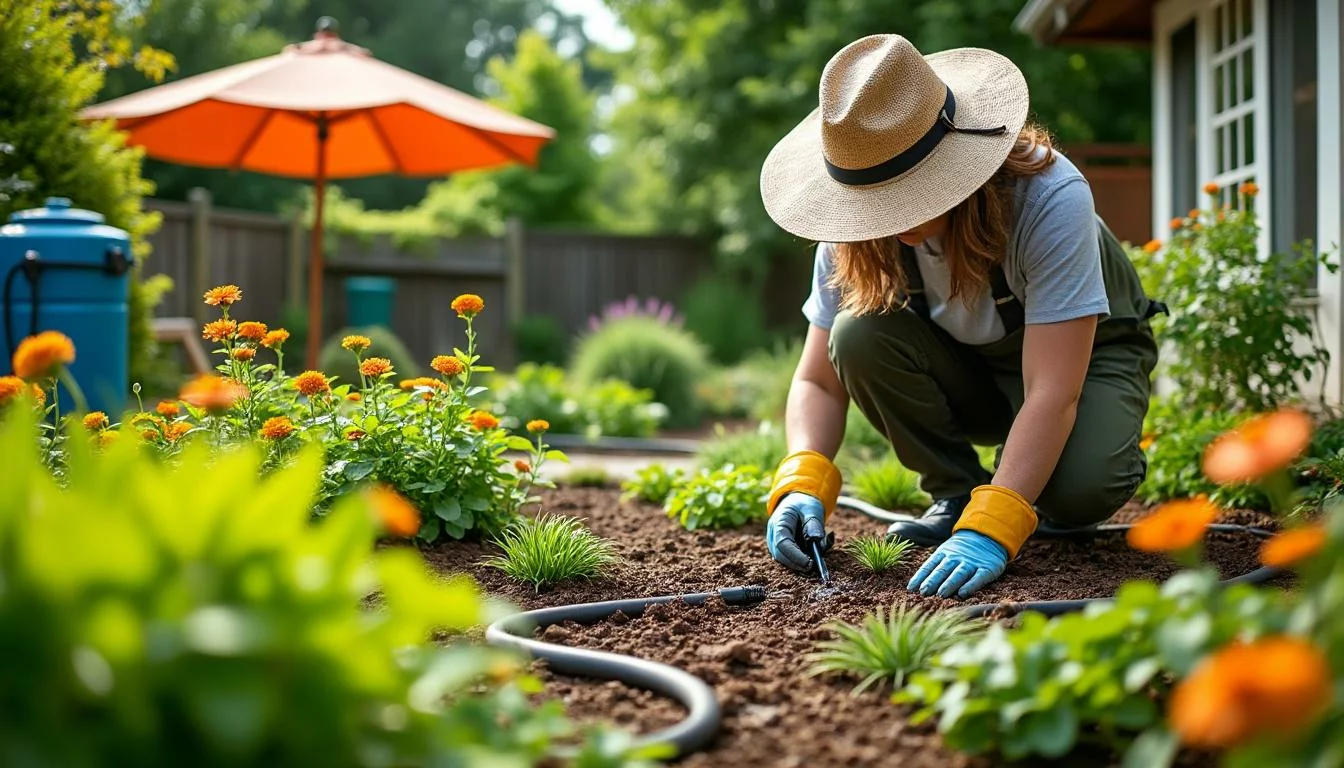As the summer heat intensifies and climate patterns shift unpredictably, managing water use in gardens has become crucial not only for sustainability but also for maintaining plant health. With water scarcity increasingly affecting regions worldwide, adopting smart watering strategies is imperative. Experienced horticulturists emphasize efficient irrigation, soil enhancement, and plant selection to reduce water consumption while ensuring vibrant gardens. Discovering which methods conserve water best without sacrificing plant vitality can transform garden maintenance from a laborious task to an optimized routine, minimizing environmental impact and resource use.
Optimizing Garden Watering During Heatwaves With Sustainable Mulching Techniques
Mulching stands out as a cornerstone practice in preserving soil moisture and reducing watering frequency, especially during prolonged heat spells. Applying a 2-3 inch layer of biodegradable mulch such as garden compost or leaf mold effectively suppresses weeds and enhances soil’s moisture retention capacity. These organic materials break down over time, enriching soil structure and nutrifying plant roots, thereby reducing the demand for frequent irrigation.
- Choose organic mulches like leaf mold or compost for added soil nutrition.
- Apply mulch evenly around plants, leaving a small buffer to prevent stem rot.
- Maintain mulch thickness between two to three inches for optimum moisture conservation.
| Mulch Type | Benefits | Recommended Thickness | Water Retention Impact |
|---|---|---|---|
| Garden Compost | Enhances soil nutrition, suppresses weeds | 2-3 inches | High |
| Leaf Mold | Improves soil structure, feeds soil microbes | 2-3 inches | High |
| Straw | Prevents evaporation, limits weed growth | 2 inches | Moderate |
Implementing Efficient Irrigation Systems To Minimize Water Usage In Summer
Incorporating advanced irrigation technologies such as drip irrigation and soaker hoses can drastically curtail water wastage by targeting moisture delivery directly to plant roots. Systems from trusted brands like Gardena, Dripworks, and Rain Bird facilitate slow, precise watering schedules that optimize soil absorption and decrease runoff. Timers from Radar and Orbit automate this process, enabling early morning or late evening watering that maximizes efficiency.
- Install drip lines or soaker hoses to deliver water exactly where roots need it.
- Use programmable timers to water during low evaporation periods, such as early mornings.
- Opt for solar-powered irrigation systems in areas lacking electrical access, combining sustainability and convenience.
| Irrigation Type | Use Case | Water Efficiency | Key Brands |
|---|---|---|---|
| Drip Irrigation | Vegetable beds, shrub rows | Very High | Gardena, Dripworks |
| Soaker Hose | Flower beds, borders | High | Rain Bird, Toro |
| Solar-Powered Timer | Remote greenhouses, raised beds | Efficient with renewable energy use | Orbit, Karcher |
Applying The ‘Right Plant, Right Place’ Principle To Reduce Water Dependency
Selecting plants based on their environmental adaptability considerably cuts down irrigation needs. Adhering to the ‘right plant, right place’ guideline means positioning drought-tolerant or sun-loving species in hot, exposed areas, thus capitalizing on their natural resilience and reducing supplemental watering. Insights from decades of horticultural experience highlight that relocating misplaced plants to optimal locations enhances their survival while economizing precious water resources.
- Assess sunlight and soil moisture levels before planting.
- Choose native or drought-resistant species appropriate for the region’s climate.
- Relocate struggling plants to suitable microclimates within the garden.
| Plant Type | Preferred Conditions | Watering Frequency | Climate Suitability |
|---|---|---|---|
| Lavender | Full sun, well-drained soil | Low | Mediterranean, temperate |
| Sedum | Dry, sandy soils | Minimal | Arid zones |
| Native Grasses | Various, often drought-tolerant | Low to medium | Regional |
Watering Containers Efficiently To Preserve Resources In Tight Spaces
Containers can be notoriously thirsty, drying out quickly under intense sunlight. Consolidating multiple plants into larger containers reduces water loss by increasing soil volume and humidity retention. Incorporating moisture-retaining additives like Miracle-Gro water storing crystals helps maintain consistent moisture levels, minimizing irrigation demands. Furthermore, drip irrigation systems adapted for pots ensure targeted watering efficiency.
- Group smaller pots to create microclimates that conserve humidity.
- Use moisture-retaining crystals to regulate watering frequency.
- Connect drip irrigation kits designed for containers to outdoor faucets for automated watering.
| Technique | Benefit | Recommended Use |
|---|---|---|
| Plant Grouping | Increases humidity, reduces evaporation | Small pots, balconies |
| Miracle-Gro Water Crystals | Stores and slowly releases water | Container soil mix |
| Drip Irrigation for Containers | Targets root zones precisely | Planters, hanging baskets |
Timing Your Watering To Maximize Efficiency During Heatwaves
Watering early in the morning before peak temperatures curtails evaporation, allowing plants to absorb moisture optimally through the hottest parts of the day. This practice not only conserves water but also minimizes disease risks linked to prolonged moisture on foliage overnight. When schedules are tight, timers from brands like Orbit and Gardena ensure timely irrigation without manual intervention.
- Water during early morning hours, ideally before 9 a.m.
- Avoid late evening watering to reduce fungal growth.
- Automate watering schedules using tech-enabled timers for consistency.
| Watering Time | Evaporation Risk | Plant Benefit | Recommended Technology |
|---|---|---|---|
| Early Morning | Low | High moisture absorption | Orbit Hose Faucet Timer |
| Late Evening | Medium | Increased fungal risk | Not Recommended |
Smart Rainwater Harvesting To Supplement Irrigation Needs
Collecting rainwater with barrels and water butts represents an eco-efficient strategy to reduce reliance on municipal water supplies. Simple setups can be implemented on any scale, while premium options enhance garden aesthetics. Positioning multiple collection vessels near garden zones helps avoid frequent hose use and preserves potable water. Aligning such systems with irrigation infrastructure from Toro or Hozelock further integrates water-saving approaches.
- Install rain barrels connected to downspouts for effective water capture.
- Distribute multiple collection points across the garden for convenience.
- Pair rainwater harvesting with irrigation for optimized watering schedules.
| Method | Advantages | Typical Capacity | Compatibility |
|---|---|---|---|
| Plastic Rain Barrels | Cost-effective, durable | 50-100 gallons | Hozelock, Toro irrigation systems |
| Decorative Rainwater Butts | Enhances garden aesthetics | 30-80 gallons | Gardena connectors |
| Gray Water Systems | Recycles household greywater | Varies | Ecoliving initiatives |
Monitoring Soil Moisture And Weather To Inform Watering Decisions
Incorporating soil moisture checks and monitoring weather forecasts are practical steps to avoid unnecessary irrigation. Relying on observational cues ensures resources are allocated only when required, preventing over-watering and root rot. Gardeners are recommended to consider local hardiness zones and forecasted rain events accessible through resources like this gardening resource to fine-tune their watering routines.
- Regularly check soil moisture two inches below surface before watering.
- Avoid watering ahead of forecasted rain to conserve water.
- Use gardening apps or local forecasts to anticipate watering needs.
| Soil Moisture Status | Watering Need | Risk if Overwatered |
|---|---|---|
| Dry below 2 inches | Water required | Low |
| Moist below 2 inches | No watering needed | High (root rot risk) |
Frequently Asked Questions About Conserving Water In Gardens
- How does mulching reduce garden watering?
Mulching retains soil moisture by minimizing evaporation, suppressing weed growth that competes for water, and gradually improves soil quality. - Are drip irrigation systems effective in large gardens?
Yes, systems from brands like Gardena and Dripworks allow targeted, efficient watering over large areas, saving time and water. - What is the best time to water plants in summer?
Early morning watering is ideal to maximize absorption and reduce evaporation; avoid late evening watering to prevent fungal diseases. - Can rainwater harvesting significantly reduce municipal water use?
Yes, collecting and using rainwater can substantially supplement garden irrigation, especially when combined with efficient watering systems. - How can I determine if my garden needs watering?
Checking soil moisture two inches deep and consulting weather forecasts helps prevent unnecessary watering and protects plants from overwater stress.

